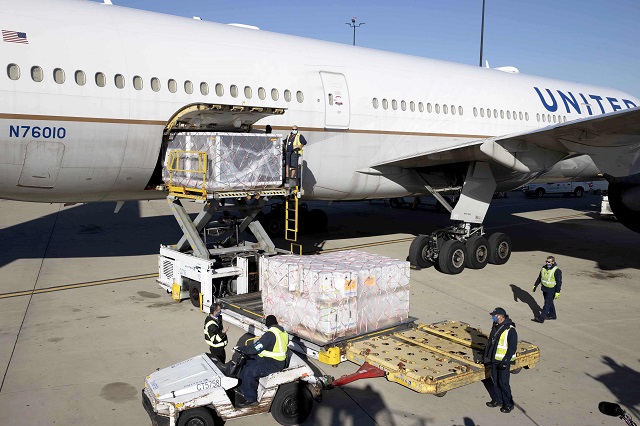There are no other means faster than the plane, which is why today air freight transport is one of the pillars of global trade and moves approximately a third of the traffic in the world.
Currently, in the context of globalization, it is the fastest and safest mode of transport, although it is also the most expensive. Do you want to know if it is the means you need to cover the logistical needs of your company?
To help you, we invite you to learn a little more about what air freight transport is and what we must take into account to get the most out of it.
Air Freight transport: pros and cons
Moving merchandise by plane is, without a doubt, the fastest way to cover great distances in record time. That is why operators have this option and we take it into account when planning our logistics strategies.
The speed of this transport reduces storage times to a minimum and speeds up deliveries, avoiding unwanted delays.
In addition, the plane is a means of transport with a high level of security. It is also very versatile, and valid for a variety of types of loads.
But there are also other factors that must be looked at. It is the most polluting and most expensive means of transport, so it is not profitable the transport raw materials or semi-manufactured products.
On the other hand, it imposes severe security restrictions and numerous technical requirements that must be properly evaluated by an experienced operator.
However, on many occasions, it is the most recommended, depending on the type of merchandise and its urgency.
Optimize air freight transport by following these 5 tips
To avoid worries and unwanted problems, you should resolve all your doubts before starting to carry out your transport by this means.
It is usual for air transport to be part of a multimodal foreign trade operation, which requires numerous procedures and must pass rigorous controls to submit to the current legislation in each country, plus the requirements of the airlines themselves.
Basically, there are two ways to carry out air transport, by regular line or using charter services. In the first case, it is easier to carry out the procedures due to the regularity of dates, times, and rates, since all the requirements are foreseen and are stable.
In the second case, it is necessary to establish specific contracts, since they are transports that carry out punctual services, tailored to the clients, for which the conditions are specifically negotiated in each case.
Therefore, if you are not an expert in logistics, the most sensible thing is to ask for professional advice to be calm, with the certainty that all the procedures are going to be carried out correctly.
In addition, it is convenient that you take into account these practical tips:
1. No rush: organize your shipments with enough time
Especially if it is the first time you use air transport to move your merchandise. There are many factors to review so that everything is in order.
Keep in mind that it is a type of transport that imposes great security measures, so you must deliver your merchandise within the deadlines stipulated by the company so that the shipment can be carried out correctly.
The merchandise will be rejected if there is no time to carry out all the previous checks and customs procedures.
2. Use the appropriate packaging
Find out in advance to pack the goods properly, especially if you have to meet special requirements, for example in the case of live animals or dangerous goods.
Airlines and cargo agents will make all the information you need available to you.
3. Consider the weight
Airplanes have limitations that must be taken into account. If your packed merchandise exceeds the maximum weight and/or volume measures that the company will provide you, costs can skyrocket and your shipment could even be left on the ground.
In the air transport of goods, what is relevant is the chargeable weight of the goods, different from the actual weight.
The chargeable weight is actually what determines the total price of the shipment because it includes the actual weight and the volumetric weight.
Because not all goods are the same. It is possible that your shipment has little real weight, but occupies a huge space in the warehouse. The companies have to take this calculation into account in order to price the shipments and organize the cargo on the ship.
It is also very important to know if your merchandise is stackable or not. As you can see, the final price depends on many factors.
In any case, weight is a key issue in air transport, since it directly affects the amount of fuel needed to make the flight.
4. Account with all surcharges
They can increase the price quite a bit, so it is convenient to have them from the first moment.
Adding fees is common. They can be of various types: customs clearance in cases of import and export, airport costs related to the use of facilities and cargo handling, fuel surcharges, transportation to or from the airport, insurance…
As you can imagine, it is essential to take all these extraordinary costs into account when calculating the profitability of your shipment.
5. Use the plane only if necessary
As we mentioned, it is an expensive and polluting means of transport, so it is advisable to use it for goods:
- Urgent, such as documentation or samples prior to closing a contract.
- Perishables, such as short-lived flowers, fruits, or vegetables.
- Of a medical or pharmacological nature, including medical equipment and humanitarian aid.
- High-value and/or fragile, such as luxury items, computers, telephony, optics, etc.
- Shipments to areas that are difficult to access by other means.
In other cases, another type of transport may be more advisable. When in doubt, take advice from a professional logistics operator and they will help you draw up a tailored strategy.
MyXBorder that offers Shipping Services ( i.e. myntra delivery to UAE, amazon India to the USA, flipkart delivery to the UK, etc ) all over the world.


